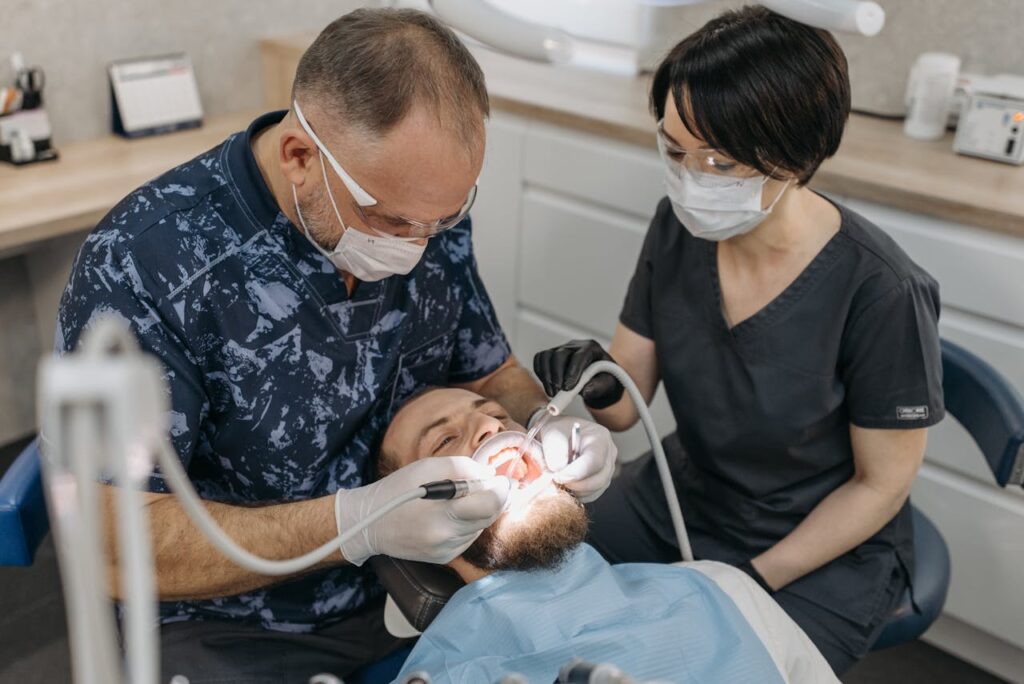Elevating healthy smiles with expert care and a gentle touch
From routine checkups to advanced treatments, we look after your whole mouth gums, teeth, jaw, and the tiny lymph and venous systems that support oral healing. With friendly faces, modern tech, and zero judgement, you’re in safe hands.


Professionals and Personalized Dental Excellence
When your smile needs thoughtful care, we’re here with clearly explained options, conservative dentistry, and comfort-first visits. Whether you’re a busy parent, a first-time patient, or coming back after a while, we tailor every plan to you.
- Personalized treatment plans
- Kid-friendly, senior-friendly
- State art imaging & sterilization
- Flexible, predictable scheduling
Complete Care for Every Smile
From routine cleanings to advanced restorations, we provide personalized dental solutions for patients of all ages.

General Dentistry
Cleanings, exams, digital X-rays, and preventive care that stop small problems before they snowball.

Cosmetic Dentistry
Whitening, bonding, veneers, and smile makeovers that look natural in person and in photos.

Pediatric Dentistry
Gentle visits that teach great habits early. Calming techniques, tiny tools, big smiles.

Restorative Dentistry
Tooth-coloured fillings, crowns, bridges, and implants built to last and feel like you.
10000+
Happy Patients
2500+
Teeth Whitened
800+
Dental Implants
15+
Years of Exeperience
Educational Studies & Oral-Systemic Links: Bridging the Gap Between Mouth and Body
Educational studies in dentistry and healthcare have increasingly highlighted the intricate relationship between oral health and overall systemic health. The term “oral-systemic link” refers to the evidence showing that conditions in the mouth can significantly affect other parts of the body. Issues such as gum disease, tooth decay, and chronic oral infections are no longer seen as isolated problems but as potential contributors to cardiovascular disease, diabetes, respiratory infections, and even complications during pregnancy. By exploring these links, research emphasizes that oral health should be viewed as an essential component of general health.
The Role of Education in Raising Awareness

Educational studies play a crucial role in spreading awareness about these connections among students, professionals, and the public. In dental schools, curricula now focus on teaching future dentists how systemic illnesses can be influenced by oral conditions, equipping them to provide more comprehensive care. Public health education campaigns also highlight the importance of brushing, flossing, and routine dental visits—not only for a healthy smile but for reducing risks of more serious health conditions. These studies bridge the knowledge gap, helping people understand that oral hygiene habits directly influence long-term well-being.
Research on Chronic Diseases and Oral Health
A large portion of educational studies focuses on how chronic diseases are linked to oral health. For example, research has shown that people with periodontal disease are more likely to develop heart problems, as bacteria from the mouth can enter the bloodstream and contribute to arterial plaque formation. Similarly, diabetes and gum disease have a two-way relationship—poor oral health can worsen blood sugar control, while uncontrolled diabetes increases the risk of severe gum infections. These findings underline the importance of collaborative care between dentists and physicians, ensuring patients receive treatment that addresses both oral and systemic conditions.
Educational Interventions and Preventive Strategies
Another key theme in educational studies is the development of preventive strategies through targeted learning. Schools and universities are incorporating oral-systemic link education into health sciences, ensuring future doctors, nurses, and dentists approach patient care holistically. Preventive strategies include integrating dental screenings into general medical checkups, promoting healthier diets, and reducing smoking—all of which improve both oral and systemic health. By focusing on education-driven interventions, healthcare systems can reduce long-term costs and improve patient outcomes, creating a more sustainable approach to wellness.
Shaping the Future of Healthcare Integration
Educational studies on oral-systemic links are shaping the future of healthcare by encouraging more integrated practices. Rather than treating oral and general health separately, there is growing emphasis on collaboration across disciplines. This integration allows for early detection of diseases, better management of chronic conditions, and a stronger focus on prevention. The future points toward healthcare models where oral health professionals work hand-in-hand with medical practitioners to provide comprehensive care. By continuing to expand educational efforts, society can move closer to understanding and embracing the true impact of oral-systemic links on overall quality of life.
Government Health Guidelines: A Roadmap to Public Well-Being
Government health guidelines act as a foundation for building healthier communities. Developed by health ministries and expert advisory bodies, these guidelines establish evidence-based recommendations to protect citizens from preventable diseases and promote overall wellness. They cover a wide range of areas, from nutrition and physical activity to vaccinations and workplace safety. By setting clear standards, governments ensure that both individuals and institutions have a reliable reference point for making health-conscious decisions.
Promoting Preventive Care

One of the strongest pillars of government health guidelines is preventive care. Instead of focusing solely on treatment, these guidelines emphasize early detection, routine screenings, and healthy lifestyle practices. Recommendations such as regular checkups, cancer screenings, and vaccinations help reduce the burden of illness and healthcare costs in the long run. Preventive measures not only save lives but also allow healthcare systems to allocate resources more effectively, ensuring communities remain resilient against future health challenges.
Addressing Nutrition and Lifestyle Choices
Nutrition, physical activity, and lifestyle habits play a critical role in shaping public health, and government guidelines highlight these factors with precision. They provide daily recommendations for balanced diets, calorie intake, and nutrient requirements tailored to different age groups. Campaigns encourage citizens to limit sugar, processed foods, and harmful substances while promoting fruits, vegetables, and regular exercise. These lifestyle-oriented guidelines aim to combat rising rates of obesity, diabetes, and cardiovascular diseases, offering practical advice to support healthier everyday choices.
Responding to Public Health Emergencies
Government health guidelines also serve as a vital tool during public health emergencies. Whether facing a pandemic, a natural disaster, or an environmental crisis, these guidelines outline protocols for safety, hygiene, and disease control. During the COVID-19 pandemic, for example, governments worldwide issued guidelines on mask-wearing, social distancing, and vaccination to minimize risk. Clear, science-based instructions provide the public with direction and reassurance in times of uncertainty, helping communities respond with unity and resilience.
Empowering Citizens Through Awareness
At their core, government health guidelines are about empowering individuals to take responsibility for their well-being. By making information accessible through public campaigns, school programs, and healthcare providers, governments ensure citizens understand the importance of health practices in daily life. These efforts bridge the gap between policy and people, fostering healthier habits across generations. Ultimately, government health guidelines function not as rigid rules but as a roadmap—one that guides individuals and communities toward sustainable, long-term well-being.
Canadian Dental Associations: Strengthening Oral Health Across the Nation
Canadian dental associations serve as the backbone of oral healthcare in the country, working tirelessly to promote better dental practices, preventive care, and access to quality services. These associations, both national and provincial, bring together professionals under one umbrella to advocate for policies, standards, and research that safeguard the public’s health. By uniting dentists, specialists, and allied professionals, they ensure Canadians receive consistent and reliable oral healthcare while raising awareness about the link between dental health and overall wellness.
Supporting Dentists and Professionals

One of the central roles of Canadian dental associations is providing support to dental professionals. They offer continuing education programs, training workshops, and professional development resources to keep dentists updated with the latest advancements in technology and treatment. By maintaining strict ethical and practice guidelines, these associations help professionals deliver high-quality care while building trust with patients. Whether a dentist is new to the profession or a seasoned practitioner, associations provide the framework and resources needed to thrive in a competitive and evolving healthcare environment.
Advocating for Accessible Dental Care
Beyond supporting professionals, Canadian dental associations also serve as strong advocates for patients. They lobby government bodies to improve funding for dental programs, expand access to underserved communities, and ensure that vulnerable populations receive the care they need. Public campaigns often focus on preventive measures such as regular checkups, fluoride use, and proper oral hygiene. By promoting policies that integrate oral health into broader healthcare systems, these associations strive to close gaps in access and reduce disparities in dental care across Canada.
Driving Research and Innovation
Another major contribution of Canadian dental associations is their investment in research and innovation. They collaborate with universities, research institutions, and policymakers to fund studies on oral diseases, treatment outcomes, and new dental technologies. From exploring the connections between oral health and systemic diseases like diabetes and heart disease to advancing sustainable practices in dentistry, their research efforts shape the future of oral healthcare. This focus on innovation not only benefits practitioners but also improves patient experiences and outcomes across the country.
Building Public Awareness and Education
Education is at the heart of Canadian dental associations’ mission. They design public campaigns to raise awareness about issues like tooth decay prevention, the dangers of tobacco use, and the importance of regular dental visits. By publishing resources, running workshops, and partnering with schools, they empower Canadians with the knowledge to take charge of their oral health. These initiatives remind communities that dental care is not just about a bright smile—it’s a crucial part of overall well-being.
Research & Canada Resources: Building Knowledge for the Future
Canada has built a global reputation as a hub of innovation, knowledge, and discovery. From advancements in healthcare to breakthroughs in technology and climate science, research has been central to shaping the nation’s future. The Canadian government, universities, and private institutions recognize that investing in research is not just about solving today’s problems—it’s about preparing for tomorrow. This commitment ensures that Canadian society can adapt to challenges, compete in global markets, and improve the overall quality of life for its citizens.
Universities as Engines of Discovery

Universities across Canada play a key role in producing valuable research. Institutions like the University of Toronto, McGill, and the University of British Columbia are internationally known for their contributions to science, engineering, and social studies. These universities not only train the next generation of thinkers but also collaborate with industries and governments to create practical solutions. Whether it’s developing new medicines, advancing clean energy, or understanding cultural diversity, Canadian universities drive research that impacts communities at home and abroad.
Government Support and National Programs
The Canadian government has long recognized the link between strong research and national progress. Agencies such as the Natural Sciences and Engineering Research Council of Canada (NSERC), the Canadian Institutes of Health Research (CIHR), and the Social Sciences and Humanities Research Council (SSHRC) provide essential funding and support. These programs encourage collaboration between researchers and industries, ensuring ideas are not just studied but also applied. By offering grants, scholarships, and innovation incentives, Canada makes sure its researchers have the resources needed to transform knowledge into action.
Community and Industry Contributions
Research in Canada is not limited to universities or government programs—industries and communities also play an important role. Companies invest in innovation to stay competitive, while nonprofit organizations focus on social and environmental research. Community-led projects, such as Indigenous knowledge research or local climate action studies, add a unique perspective that strengthens Canada’s overall research capacity. These partnerships ensure that knowledge is both inclusive and impactful, addressing the real needs of people across the country.
The Future of Canadian Research Resources
Looking ahead, Canada’s ability to remain at the forefront of global research depends on continued investment and collaboration. Emerging fields such as artificial intelligence, biotechnology, and sustainable development are opening new opportunities for discovery. At the same time, ensuring equitable access to resources—such as research libraries, digital archives, and open data platforms—will allow more people to participate in the knowledge economy. By combining technology, funding, and human talent, Canada is well-positioned to keep building a future where research empowers society at every level.
Healthy Living: How Lifestyle Choices Prevent Chronic Disease
Lifestyle choices play one of the most significant roles in determining long-term health outcomes. The way we eat, move, sleep, and manage stress influences how our body functions daily and how resilient it remains against diseases. Unlike genetic factors, lifestyle is something we can actively shape, making it a powerful tool for preventing chronic illnesses. Research consistently shows that healthy routines lower the risk of conditions such as heart disease, diabetes, and hypertension. By making mindful decisions each day, we create a strong foundation for lifelong wellness.
Nutrition as a Preventive Medicine

What we put on our plate is often the first line of defense against chronic disease. Diets rich in fruits, vegetables, whole grains, lean proteins, and healthy fats supply the body with essential nutrients that fight inflammation and strengthen immunity. Conversely, diets high in processed foods, sugar, and unhealthy fats contribute to obesity, diabetes, and cardiovascular disease. For example, the Mediterranean diet has been widely praised for reducing heart disease risk by emphasizing plant-based foods and healthy oils. Making small but consistent dietary changes—like reducing sugary drinks or adding more fiber—can significantly impact disease prevention.
Physical Activity and Its Protective Benefits
Regular physical activity is one of the most effective lifestyle habits for preventing chronic illness. Exercise helps regulate weight, improves circulation, and enhances the body’s sensitivity to insulin, which lowers the risk of type 2 diabetes. It also strengthens the heart and lungs, reducing the chances of cardiovascular problems. Beyond physical benefits, activity boosts mental health, lowering stress and depression that often contribute to poor lifestyle choices. Experts recommend at least 150 minutes of moderate activity per week, but even daily walking, cycling, or dancing can help keep chronic diseases at bay.
Stress, Sleep, and Emotional Well-Being
Chronic stress and lack of quality sleep often act as silent contributors to long-term health issues. High stress triggers hormonal imbalances, raising blood pressure and weakening the immune system, while poor sleep has been linked to obesity, heart disease, and diabetes. Emotional well-being also plays a role—people who practice mindfulness, meditation, or relaxation techniques tend to cope better with life’s challenges and make healthier choices overall. Prioritizing rest, setting regular sleep routines, and finding constructive ways to manage stress are vital strategies for preventing chronic illnesses from taking root.
Building a Sustainable Prevention Plan
The prevention of chronic disease isn’t about perfection but about sustainable, long-term habits. Small daily actions—such as cooking balanced meals at home, walking instead of driving short distances, or setting aside time to unwind—accumulate into major health benefits. Regular health check-ups, screenings, and open communication with healthcare providers add an extra layer of protection, ensuring early detection of risk factors. Community support, whether through family, friends, or wellness programs, makes healthy living easier and more enjoyable. Ultimately, disease prevention through lifestyle is about creating balance—nourishing both body and mind in ways that strengthen health and extend quality of life.
Blood Circulation, Diabetes & Oral Health
Good blood circulation is the lifeline of every organ in the body, including the mouth. Healthy gums and teeth rely on a steady flow of oxygen-rich blood that delivers nutrients and removes waste. When circulation is impaired, tissues in the mouth struggle to heal from infections or everyday wear and tear. Poor circulation also reduces the body’s ability to fight off bacteria, making the gums more vulnerable to disease. In short, circulation acts like the delivery truck of your body—when it slows down, can everything from gum tissue repair to inflammation control suffers.
How Diabetes Affects Blood Flow

Diabetes is one of the most common conditions that interferes with circulation. Elevated blood sugar levels damage blood vessels over time, causing them to stiffen and narrow. This restricts the flow of oxygen and nutrients, especially to smaller blood vessels in the gums. As a result, people with diabetes are at a higher risk of gum disease, delayed healing after dental treatments, and frequent oral infections. Diabetic neuropathy, which affects nerves, can also reduce sensations in the mouth, masking early warning signs of oral problems. Together, these changes create a cycle where poor circulation and diabetes amplify each other’s effects.
The Connection Between Diabetes and Gum Disease
Gum disease, or periodontal disease, is particularly common in people with uncontrolled diabetes. High blood sugar creates an environment where harmful bacteria thrive, fueling gum inflammation. At the same time, the weakened circulation caused by diabetes makes it harder for the gums to recover. This two-way relationship means diabetes worsens gum disease, and gum disease can in turn make blood sugar levels harder to control. Swollen, bleeding gums, loose teeth, and persistent bad breath are all warning signs that shouldn’t be ignored. Addressing gum health is not only about protecting your smile—it’s also a vital part of managing diabetes.
Also read this: https://lymphovenous-canada.ca/research-canada-resources-building-knowledge-for-the-future/
Why Oral Health Matters for Overall Circulation
Poor oral health doesn’t just stay in the mouth. When gum disease progresses, bacteria and inflammation can enter the bloodstream, spreading throughout the body. This adds stress to the heart and circulatory system, increasing the risk of cardiovascular disease. For individuals with diabetes, this added burden makes already vulnerable blood vessels more prone to complications like heart attacks, strokes, and poor wound healing. Keeping the mouth healthy, therefore, is not only about avoiding cavities—it’s an essential strategy for protecting blood circulation and lowering overall health risks.
Practical Steps for Better Oral and Circulatory Health
Managing diabetes and protecting circulation begins with consistent self-care. Regular dental visits allow for early detection of gum issues before they escalate. Daily brushing and flossing help reduce bacteria that fuel gum disease, while quitting smoking improves both circulation and oral health dramatically. Maintaining blood sugar levels through balanced eating and exercise also keeps blood vessels healthier. For those already facing circulation challenges, dentists may recommend specialized cleanings or treatments to strengthen gum tissues. Small, consistent steps—like staying hydrated, eating nutrient-rich foods, and monitoring blood sugar—go a long way in keeping both the mouth and the circulatory system in balance.
